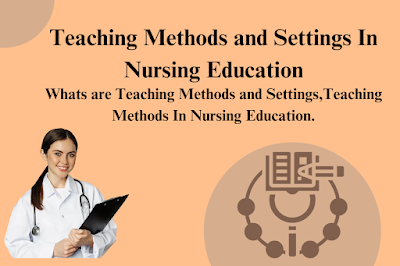The Teaching Methods and Settings In Nursing Education. Nursing education uses a variety of teaching methods and environments to prepare students for professional practice.
These include classroom lectures, clinical rotations, simulation labs, and online learning platforms. Active learning techniques, collaborative learning, and clinical teaching methods are also frequently used.
The Teaching Methods and Settings In Nursing Education
Effective teaching is often perceived as a natural talent, exemplified by the phrase, “Now, there is a born teacher!” However, excellent teaching is more accurately described as a learned skill that involves a thorough understanding of the educational process. This includes knowing which teaching methods are most suitable for various contexts and learners.
Selecting the most appropriate teaching methods hinges on several factors, including the learners’ age and developmental stage, their prior knowledge, the content to be taught, the educational objectives, and the resources available—such as time, space, and materials. Additionally, the physical setting plays a crucial role in determining the most effective approach.
Creating stimulating and effective learning experiences is not a matter of chance but rather a deliberate process. It involves strategically using one or several teaching methods to achieve the desired learning outcomes (Rothwell, Benscoter, King, & King, 2016; Rothwell & Kazanas, 2008).
Defining Teaching Methods and Instructional Materials
A teaching method refers to the approach used to deliver content and engage learners with the material. Common teaching methods include:
- Lecture: A structured presentation of information delivered by the instructor.
- Group Discussion: Interactive dialogue among learners to explore concepts and ideas.
- One-to-One Instruction: Personalized teaching between an instructor and a learner.
- Demonstration and Return Demonstration: Showing a procedure or skill followed by the learner replicating the action.
- Gaming: Utilizing educational games to reinforce learning.
- Simulation: Using simulated environments or scenarios to practice skills.
- Role Play: Acting out scenarios to understand and apply concepts.
- Role Model: Demonstrating behaviors or skills for learners to emulate.
- Self-Instruction Modules: Independent learning resources such as online modules or printed materials.
With the advancement of technology, many of these methods are now available in blended formats that integrate online and hybrid learning strategies (Cook et al., 2008; Johnson, Adams, & Cummins, 2012).
Instructional materials or tools, on the other hand, are the resources used to support and enhance teaching. These include:
- Audience Response Systems (ARS): Tools for interactive participation.
- Books and Printed Handouts: Traditional resources for reading and reference.
- Videos and Podcasts: Audio-visual materials that complement teaching.
- Posters: Visual aids that reinforce key concepts.
It is crucial to distinguish between teaching methods and instructional materials. Although often used interchangeably, they serve different purposes. Teaching methods involve the strategy of instruction, while instructional materials are supplementary tools that aid in delivering content.
Teaching Methods in Nursing Education
In nursing education, no single teaching method suits all learners or settings perfectly. Similarly, no method is universally superior for achieving behavioral change across the three learning domains—cognitive, affective, and psychomotor. Effective teaching often involves combining multiple methods and instructional materials to enhance learning outcomes (Friedman, Cosby, Boyko, Hatton-Bauer, & Turnbull, 2011).
Selecting appropriate teaching methods is vital for addressing learners’ needs. The Chinese proverb, “Tell me; I forget. Show me; I remember. Involve me; I understand,” encapsulates the idea that active involvement in learning enhances retention and critical thinking. Employing methods that engage learners actively can significantly improve their ability to understand and apply new information (Ridley, 2007; Tedesco-Schneck, 2013).
Application of Teaching Methods and Settings
Throughout this chapter, various examples demonstrate how to apply different teaching methods effectively to enhance learning experiences. Additionally, it addresses the diverse settings in which nurse educators operate, highlighting the need for adaptability and strategic planning in teaching.
In summary, effective teaching in nursing education requires a thoughtful approach to selecting and applying various methods and materials. By understanding the distinctions between teaching methods and instructional tools, and by integrating these approaches in a tailored manner, educators can improve the efficacy of their teaching and positively impact learner outcomes.
Teaching Methods and Settings In Nursing Education
Teaching Methods and Settings In Nursing Education
Teaching Methods and Settings In Nursing Education
Teaching Methods and Settings In Nursing Education
Teaching Methods and Settings In Nursing Education
Read More:
https://nurseseducator.com/didactic-and-dialectic-teaching-rationale-for-team-based-learning/
https://nurseseducator.com/high-fidelity-simulation-use-in-nursing-education/
First NCLEX Exam Center In Pakistan From Lahore (Mall of Lahore) to the Global Nursing
Categories of Journals: W, X, Y and Z Category Journal In Nursing Education
AI in Healthcare Content Creation: A Double-Edged Sword and Scary
Social Links:
https://www.facebook.com/nurseseducator/
https://www.instagram.com/nurseseducator/

I am sure this article has touched all the interrnet viewers, its really really good paragraph on building up new
website. http://boyarka-inform.com
Good day! I know this is somewhat off topic but I was wondering if you knew where I could get a captcha plugin for my
comment form? I’m using the same blog platform as yours and I’m having trouble finding one?
Thanks a lot!
I am sure this piece of writing has touched all the internet viewers, its really
really fastidious article on building up new webpage.
Официальный кракен тор браузер скачивайте только с сайта torproject.org для безопасного входа на площадку с многоуровневым шифрованием всего трафика.
Uwielbiasz hazard? casino nv: rzetelne oceny kasyn, weryfikacja licencji oraz wybor bonusow i promocji dla nowych i powracajacych graczy. Szczegolowe recenzje, porownanie warunkow i rekomendacje dotyczace odpowiedzialnej gry.